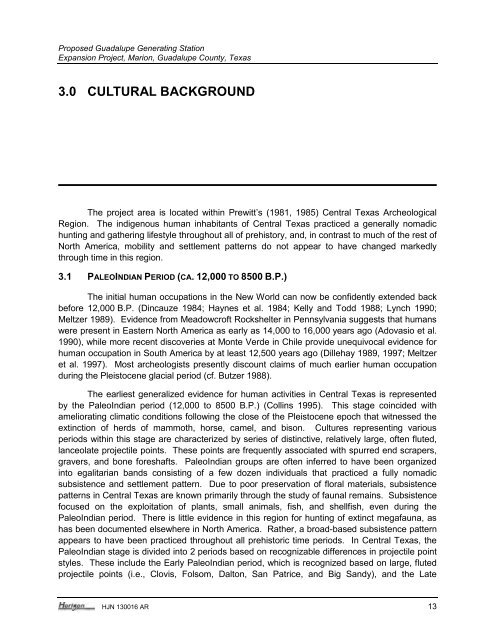Guadalupe Generating Station Final Cultural Resourse Report - US ...
Guadalupe Generating Station Final Cultural Resourse Report - US ...
Guadalupe Generating Station Final Cultural Resourse Report - US ...
Create successful ePaper yourself
Turn your PDF publications into a flip-book with our unique Google optimized e-Paper software.
Proposed <strong>Guadalupe</strong> <strong>Generating</strong> <strong>Station</strong><br />
Expansion Project, Marion, <strong>Guadalupe</strong> County, Texas<br />
3.0 CULTURAL BACKGROUND<br />
The project area is located within Prewitt’s (1981, 1985) Central Texas Archeological<br />
Region. The indigenous human inhabitants of Central Texas practiced a generally nomadic<br />
hunting and gathering lifestyle throughout all of prehistory, and, in contrast to much of the rest of<br />
North America, mobility and settlement patterns do not appear to have changed markedly<br />
through time in this region.<br />
3.1 PALEOINDIAN PERIOD (CA. 12,000 TO 8500 B.P.)<br />
The initial human occupations in the New World can now be confidently extended back<br />
before 12,000 B.P. (Dincauze 1984; Haynes et al. 1984; Kelly and Todd 1988; Lynch 1990;<br />
Meltzer 1989). Evidence from Meadowcroft Rockshelter in Pennsylvania suggests that humans<br />
were present in Eastern North America as early as 14,000 to 16,000 years ago (Adovasio et al.<br />
1990), while more recent discoveries at Monte Verde in Chile provide unequivocal evidence for<br />
human occupation in South America by at least 12,500 years ago (Dillehay 1989, 1997; Meltzer<br />
et al. 1997). Most archeologists presently discount claims of much earlier human occupation<br />
during the Pleistocene glacial period (cf. Butzer 1988).<br />
The earliest generalized evidence for human activities in Central Texas is represented<br />
by the PaleoIndian period (12,000 to 8500 B.P.) (Collins 1995). This stage coincided with<br />
ameliorating climatic conditions following the close of the Pleistocene epoch that witnessed the<br />
extinction of herds of mammoth, horse, camel, and bison. Cultures representing various<br />
periods within this stage are characterized by series of distinctive, relatively large, often fluted,<br />
lanceolate projectile points. These points are frequently associated with spurred end scrapers,<br />
gravers, and bone foreshafts. PaleoIndian groups are often inferred to have been organized<br />
into egalitarian bands consisting of a few dozen individuals that practiced a fully nomadic<br />
subsistence and settlement pattern. Due to poor preservation of floral materials, subsistence<br />
patterns in Central Texas are known primarily through the study of faunal remains. Subsistence<br />
focused on the exploitation of plants, small animals, fish, and shellfish, even during the<br />
PaleoIndian period. There is little evidence in this region for hunting of extinct megafauna, as<br />
has been documented elsewhere in North America. Rather, a broad-based subsistence pattern<br />
appears to have been practiced throughout all prehistoric time periods. In Central Texas, the<br />
PaleoIndian stage is divided into 2 periods based on recognizable differences in projectile point<br />
styles. These include the Early PaleoIndian period, which is recognized based on large, fluted<br />
projectile points (i.e., Clovis, Folsom, Dalton, San Patrice, and Big Sandy), and the Late<br />
HJN 130016 AR 13
















